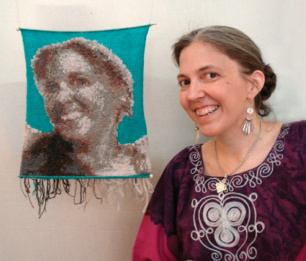
Sipp-a-Roo ColorJoy by LynnH
? 2008 by Lynn D.T. Hershberger http://ColorJoy.com · Lynn@ColorJoy.com A perfect bag for a small aowenture! Sometimes we need to take a bottle of water along on a jaunt, but no hand is available to hold it. A shoulder-strap version is fine for walking. However, on a bicycle or when pushing a stroller it is better to find a hands-free method with a short strap. This felted bottle bag fits a common half-liter bottle (with hints for larger bottles). Here is a kangaroo pouch, easily accessible, for on-the-go folks with style. Intermediate (knitting in the round on DPN's, stranded colorwork) Constructiou: In the round on 4 double-pointed needles (3 holding, 1 working); begun with stockinette rectangle. Double I-Cord strap with buttonhole. NeedUe Size: 1 set (of five)size 6.5mm / 10-1/2 US double-pointed needles (DPNs). Gauge: Appx. 16 st / 4 inches stranded stockinette in the round, before felting (mine was 5 st / in stranded before blocking. Gauge is not crucial in this pattern. If you know you habitually knit very snugly or very relaxed, change needle size to adjust appropriately. Yarn:(1) $100\mathrm{gm}$ skein of MC1 (main color) standard knitting worsted, solid color, with appx. 220 yd to $100\mathrm{gm})$
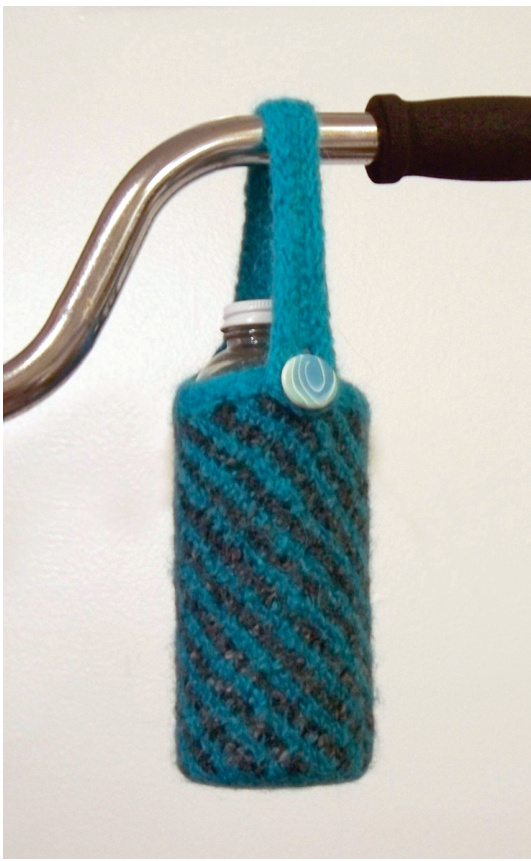
(1) $50\mathrm{gm}$ skein of contrasting CC1, with 105yd per $50\mathrm{gm}$ (I actually used under $25\mathrm{gm}$ Sample in photo used Nashua Creative Focus Worsted wool/alpaca Turquoise CFW3743 (MC), and Di.Ve Autunno Grey/Turquoise 48162 (CC). Color Hint: Go for either warm/cool contrast or dark/light contrast. Contrast is key to sucess! Notios/as: Oneuton (choosafter feling, toe sure ofbuttonole size and slightlysmaller plainbackinuttha ing neede withthrea-sizyeandl/in reaaing needle/large eyed needle for working ends in. Yar :M:MalabrigWrsted snside CaadePatonlasMen Classic. CC: Southwest Trading Karaoke solid. Also try any of the MC suggestions. Sizes: The pictured bag fits a half-liter bottle which measures 9inch / $23\mathrm{cm}$ circumference and 7-1/2inch / $19\mathrm{cm}$ tall. (Hints included for bottles appx. 10 inch/ 25cm circ., any height.) NtTyadlfila the size of your own project. My bags fnished at approximately $80\%$ of their pre-washed size, and fete rather easily.
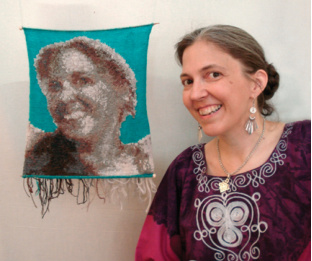
Sipp-a-Ro0 ColorJoy by LynnH
2008 by Lynn D.1. Hershberger http://ColorJoy.com · Lynn@ColorJoy.com [Abbreviations K: Knit. P: Purl. St: Stitch. Rnd: Round. BOR: Beginning of Round. M1: Make One. Increase by creating a backward e-wrap loop like the cast on shown below. (If you prefer, you can instead pull up the loop between stitches from previous row, knitting into that twisted lop.) Sl: Slip (as if topurl). Entr stitch with right nede facing lft, where the tips ofboth needles are pointing in opposit directions. Pullstitch onto right needle without making a stitch. This method avoids twisting the stitch. MC: Main Color, solid color, includes strap. CC: Contrast Color. Kfb: Knit in Front and Back of next stitch (an increase). PU: Pick up and knit (make new stitches with new yarn at a finished edge).
BEGIN BAG
We start with a simple rectangle. This rectangle will become the center of the bottom of your bag. You will knit flt for 8 rows. After the 8 rows, you willstart to knit in the round.
CAST ON
Using size 10 1/2 DPNS, cast on 8 sts on with backwards loop (also called halfhith/-wrap).
BASE RECTANGLE
This rectangle will become the very tip of your mitten.You will work flat to get started. Afe this, you will transition and knit in the round. Note:Throughout this patern, llsliedstchesae slipedas i to purl Your eedleswilhae their tis pointing in different directions, rather thanboth toward the ceiling.) This makes sure the stitches are not twisted on the needl after sipping. Worka in ttfrwssltst tichfallt tst as

You are done with your rectangle when you have finished purling Row 8 and are ready to knit again. Your rectangle may look as though you have fnished only 7 rows, because the fnal purl row is stillon the needle. Do not include the cast-on row in your count. Copyright 2008 LynnDT Hershberger (LynnH)- Page 2 Sipp-a-Roo -February 2008
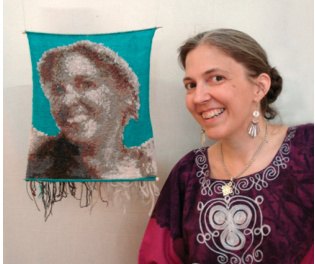
Sipp-a-Ro0 ColorJoy by LynnH
@ 2008 by Lynn D.T. Hershberger http://ColorJoy.com $\bullet$ Lynn@ColorJoy.com BEGIN KNITTING CIRCULARLY We now will knit aroud theedge of therctangle This involves pickingup and kitting creating nw ttch with working yarn) on the three edges where you not currently have live stitches on your needle.
Transition Stitches
Knit 4 sts (later this needle will hold 6 sts). Note: the pointafter this transition ill become the center of your palm. It also will be the Beginning Of your Round (BOR). You do not need a stitch marker to mark the BOR, because the triangle of needles will be asymmetrical and you will be able to identify the spot as you work. If you prefer to divide stitches evenly by adding another needle, mark the fabric here with a safety pin or pin-like stitch marker anchored into the fabric.
Neede 1
With a new needle, knit the remaining 4 sts from the original needle. Continuing to use the same needle, turn corner and pick up and knit in the frst 2 chain stitches from the side edge.
Neede 2
With a new needle, pick up and knit in the other 2 chain stitches from the frst side edge. Turn corner counterclockwise. Continuing with same ndl, PU into the first 4 cast-on stitches from your starting edge. Count carefullybefore you start,to fnd all the stitches you need. Usually you need tofudge an extra stitch at the end of thisedge.
Neede 3
With new neede pickup and knit in the last 4 cast on sts (this corner is wonky, pick up where you can) un corner counter-clockwise, and PUinto the frst half of the chain sts (2 sts) on the second side edge ofthe starting rectangle. Neede 4 Start with yet another ndl. PU in the last half of the chain sts from the final side edge (2 sts). Then onto this same ndl, knit the 4 transitional stitches you worked at the beginning of the circular process. Note that this point will become the Beginning Of Round, or BOR. Secure a safety pin or other marker into the fabric of the bag at this point for reference when working chart. You now have 24 stitches divided evenly over 4 needles.
Increase Round
For one round, Kfb in every stitch. You should now have 48 total stitches.
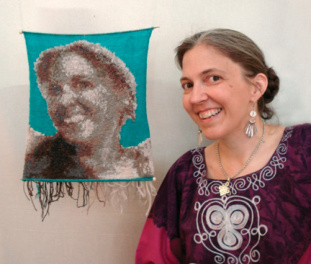
Sipp-a-R00 ColorJoy by LynnH
@ 2008 by Lynn D.T. Hershberger http://ColorJoy.com $\bullet$ Lynn@ColorJoy.com
Transition Round
K all sts in MC. (If you have a larger bottle which measures appx. 10 inches / $25\;\mathrm{cm}$ on this round instead $^{*}\mathrm{k}5$ $\mathrm{Kfb^{*}}$ repeat to end, increasing total stitches to 56. You willalso knit the bag taller. This willrequire more yarn.)
COLORWORK SECTION
(If making larger bag, redistribute your stitches so that each needle holds a multiple of4 stitches.) Knit chart for approx. 9inch $/\;23c\mathrm{m}$ of colorwork (on my bag this included 4 full repeats/32 rows), repeating rows 1-8 from bottom to top,stopping mid-chart if necessary. (Ifyou are making bag for a larger bottle, measure the height you wish and multiply times 1.2; then knit that resulting measurement before starting the top edge.)
PURL RIDGE/TOP EDGE
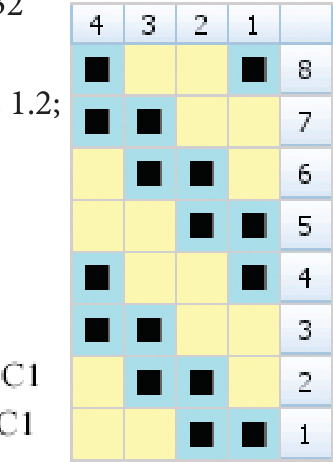
Cut CC. Remainder of bag is knit in MC1. Transition Round K all sts for 1I full Rnd. (You may need to re-distribute stitches between needles a times during each round at this point.)
Decrease Rndl:
\*P1, P2Tog, P2Tog, P1, P2Tog\*, repeat to end. You didhave a multiple of 8 stithes, now you have a multiple of 5 If you are offby a stitch or two, do not worry as it will not be obvious. (If you chose a larger bag, the repeat will not work evenly. Just stop when the round is done.)
Purl Full Rnd
Now you will knit around where you pick up abump on the inside, tomake a stronger and nicer-lking ede. JB: Join Bump. Here's how: Pick up one “purl bump" from inside (behind the last knit row) and mount on left-hand needle. Knit this together with the next stitch, as a K2Tog. Notes:amake certaint pick up anC purbmp; bbecausofth decreae row,thpurl bump neednt be directly below the stitch you are working; just choose a nearby purl bump in MC.
The Join-Bump Round
\*JB, K1, JB, $K2^{*}$ Repeat to end of Rnd. (If you chose a larger bag, the repeat willagain not work evenly.) Copyright 2008 Lynn DT Hershberger (LynnH) - Sipp-a-Roo - February 2008
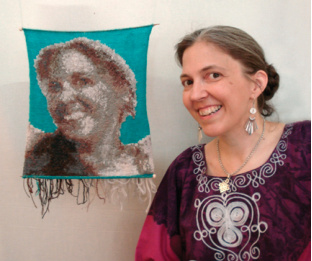
Sipp-a-R00 Coloroy by LynnH
@ 2008 by Lynn D.T. Hershberger http://ColorJoy.com $\bullet$ Lynn@ColorJoy.com
Cast Off
Cast off using either a US single-crochet (not sure what I call single crochet is called in the UK) or this stretchy alternative cast off:
Stretchy Alternative Cast Off
Knit 2 sts. Place those two stitches back on the left needle and K those 2 sts together through back loop (TBL), creating one St on right needle. $^{*}\mathrm{Kl}$ more, place both stitches back on the left needle and K them tog TBL.\* Repeat chosen cast of for entire round until one st remains on RH needle. Break/cut yarn. Pullyarn end through last loop to fasten. Work in all existing ends.
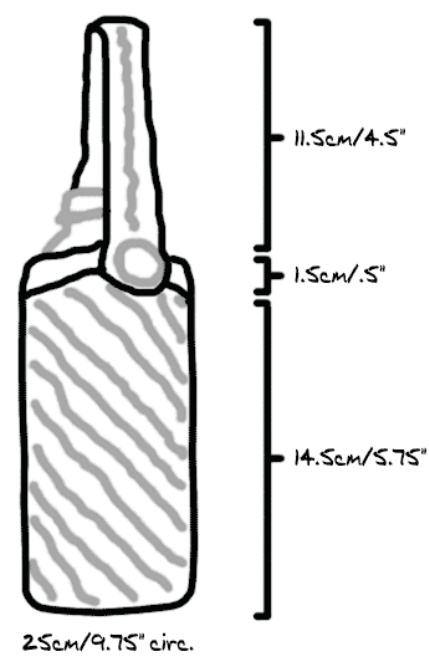
BUTTON STRAP
PU 9 sts just under cast-off edge. Transition Turn work and purl back one row. Working yarn willpa ver cast ofstitches in ne spot) Turn again to face outside of bag.
Double-l-Cord
Cording Row: Knit 5 sts, bring yarn forward between needles, slip 4 sts as if to purl (do not twist sts). Turn work. Repeat cording row (pulling yarn across back of 4 sts to wrap first stitch). These 2 rows $=1$ garter ridge. Continue toknit double I-cord as in above boxuntil you count 31 garter ridges on the center stitch ofthe strap and are ready to begin a right-side row.
Buttonhole and Strap Finish
K3, SSK, YO (loosely) ending with yarn in front, slip 4 sts as ifto purl. Tun. K5 (loosely), bring yarn forward, Slip 4 purlwise. Knit 2 more cording rows as above. Cast ofuntil remain on lft nedle. KTog those on lft nedle, lift right stitch over let to cast off final stitch, cut/break yarn, pull end through, (making final loop no longer a lop). With lare-eyed neede, work yar end verylosely onuderside of fap, around thebuttonholDo not tigten this at all in fact, stretch hole gently with your ngertips tolosen abit. The extra wool willstrengthen thhle. Work in all remaining ends.
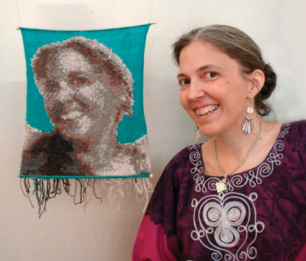
Sipp-a-Roo ColorJoy by LynnH
@ 2008 by Lynn D.T. Hershberger http://ColorJoy.com $\bullet$ Lynn@ColorJoy.com
SHRINK/FULL/FELT
Place bag in nylon net wash bag or pillowcase. Place in washer with a few items of the same general color groupings, and which do not hold lint. Jeans work well if the colors are compatible, towels do not. Wash in a load with much agitation and a small amount of detergent/laundry soap (or no-rinse wool wash of your choice). Check first after 10 minutes, then every 5. Stretch into shape every time you check. Stop when size is satisfactory and fabric is to your liking. Rinse gently in warm water, blot partially dry, place bottle inbag and leave in well-ventilated area to dry fully. Note: You can shrink byhand with abit of soap/detergent and rubbing or otherwise adding friction evenly. It takes a while just relax into the process.
FINISHING
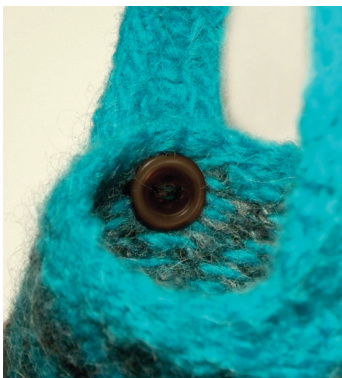
Attach button using standard sewing needle and strong buttonhole thread or strong doubled sewing thread. Use a smaller backing button on inside during sewing (sew both buttons on at one time) to strengthen the area, as shown in photo:
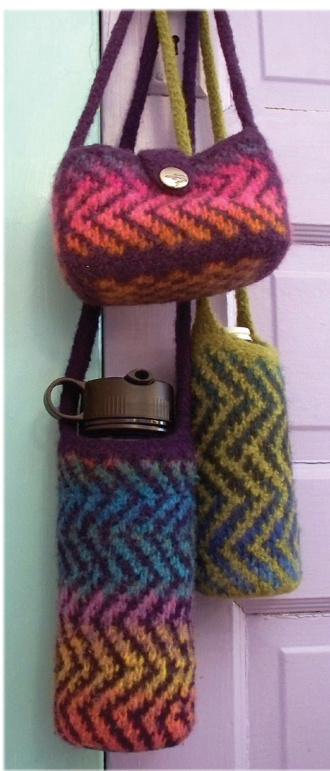
Lynn D. TroldahL Hershberger (AKA LynnH) LynnH has always been focused on color. whether it be polymer clay, printmaking orfiber. Visit LynnH's SockTour, patterns, handpainted yarns and blog/column at http://www.ColorJoy.com, or write to her at: Lynn@ColorJoy.com Try another ColorJoy by LynnH pattern! Visit http:// ColorJoy.cow/shop
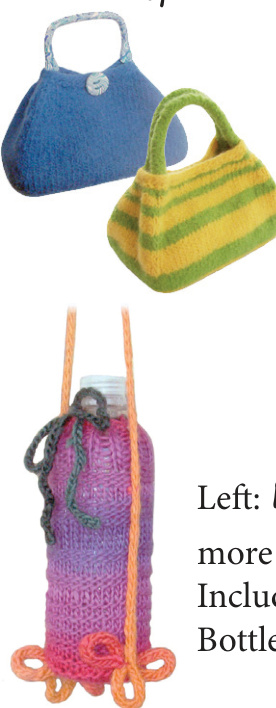
Left: Sassy Suwmer Handbag You want a quick weekend knit, You need a smaller bag for summer, You like color, -or- You are interested in Fibonacci Stripes. Right: ZigBagZ Mini CoUection BottleZig: For active folks on the go, half-liter or sport. SportZig: Holds a liter water bottle or a 2-cup Thermos(tm). BabyZig: Perfect for wallet, keys and cell phone.
Left: Bags to Go!
more of a formula than a pattern, putting you in charge of final size. Included are guidelines to make one of two different types of bags (Water Bottle Holder, and Sunglasses/ Camera/ Wallet Holder).









